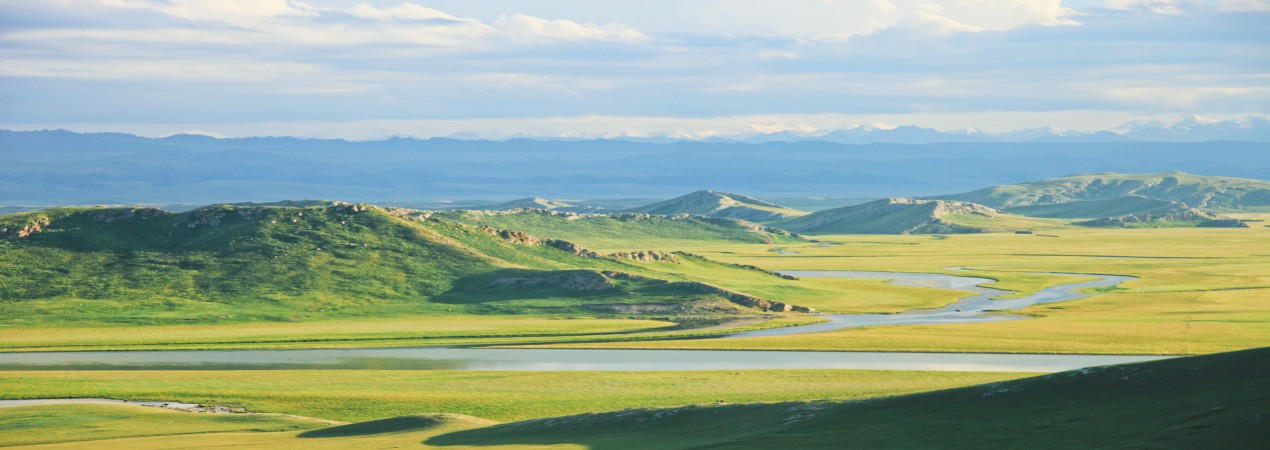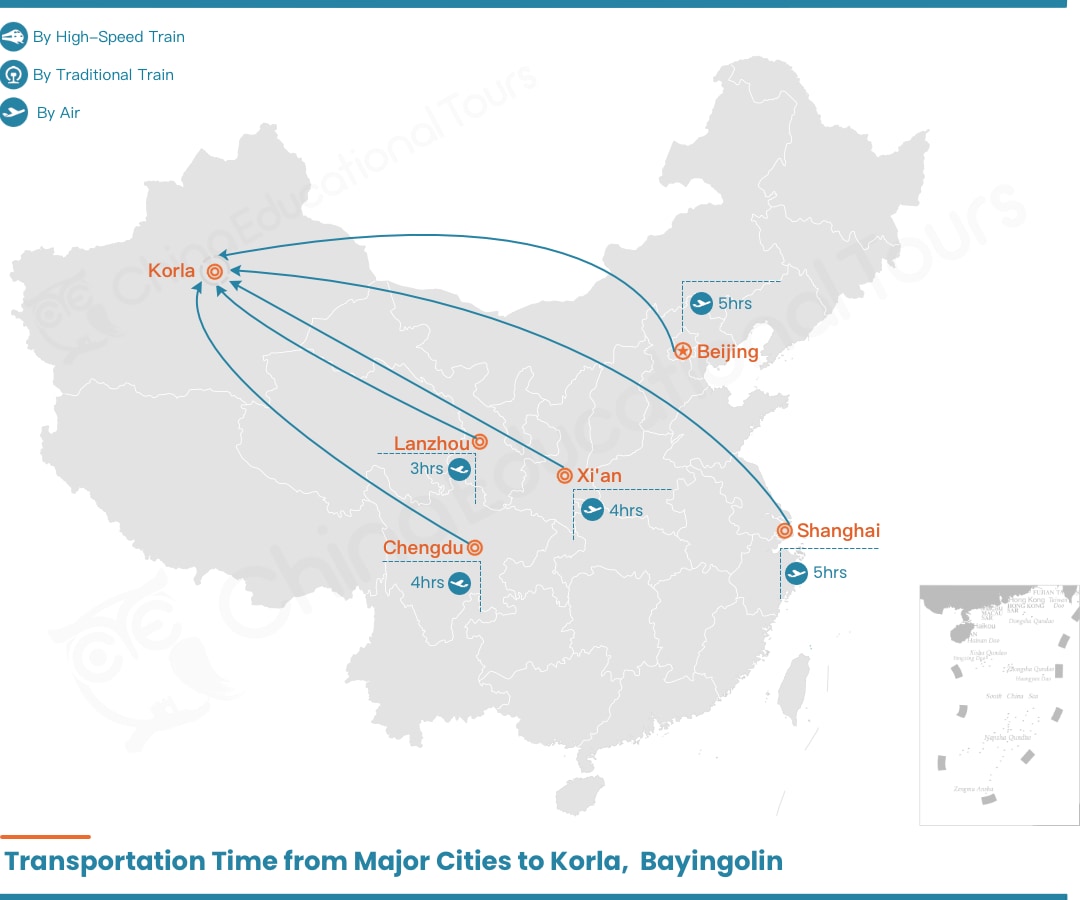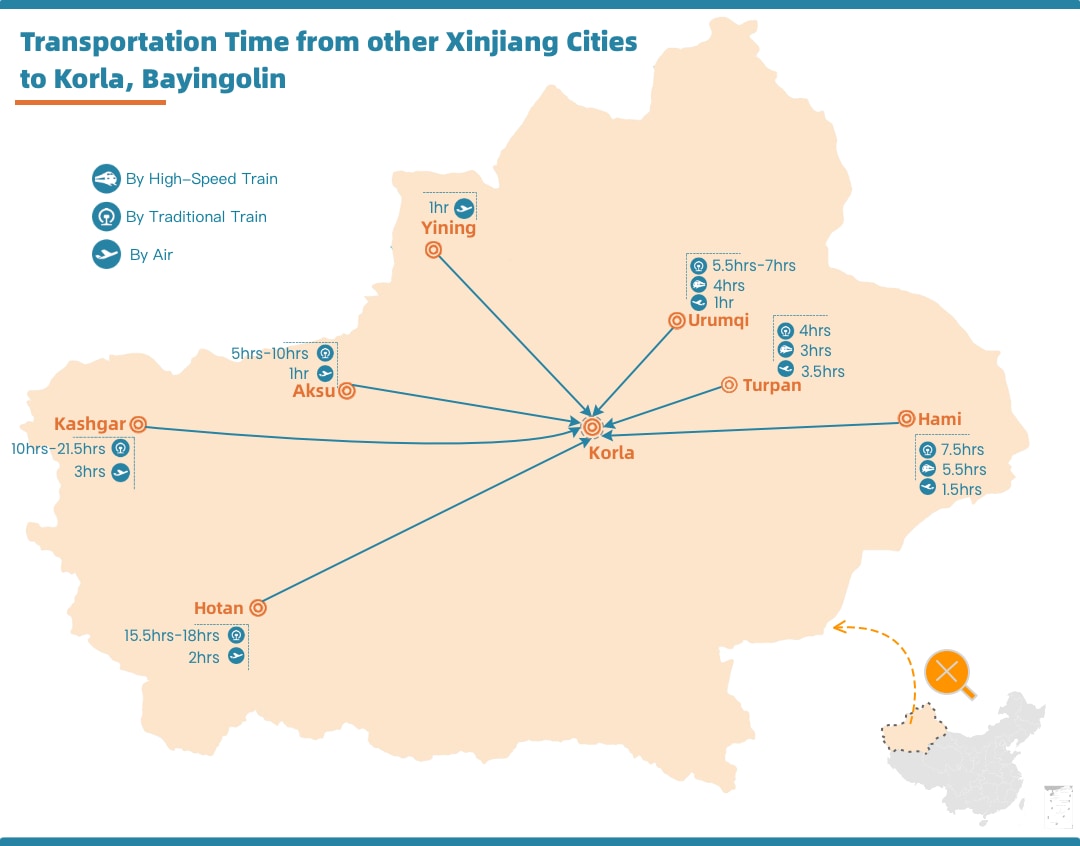Bayingolin Travel Guide

Bayingolin Mongolian Autonomous Prefecture, referred to as Bazhou, takes its name "Bayingolin" from Mongolian, which means "a fertile river basin". It is under the jurisdiction of the Xinjiang Uygur Autonomous Region and located in the southeast of Xinjiang Uygur Autonomous Region. The administrative area of the prefecture is 471,500 square kilometers, accounting for a quarter of the total area of Xinjiang, making it the largest prefecture-level administrative region in China. Bayingolin Mongolian Autonomous Prefecture has a typical continental climate, with four distinct seasons and a large temperature difference between day and night.
- English Name: Bayingolin Mongolian Autonomous Prefecture
- Chinese Name: 巴音郭楞蒙古自治州 (bā yīn guō léng méng gǔ zì zhì zhōu)
- Government: An autonomous prefecture in Xinjiang Uygur Autonomous Region
- Location: Southeastern part of Xinjiang, China (Roughly between 35°38′N - 43°36′N, 82°38′E - 93°45′E)
-
Area code & Zip Code:
Area Code: 0996; Zip Code: 841000 - Airports:Korla Licheng Airport(KRL), Qiemo Yudu Airport(IQM), Ruoqiang Loulan Airport(RQA) and Hejing Bayinbulak Airport(HJB)
-
Railway Stations:
Korla Railway Station, Ruoqiang Railway Station, Heshuo Railway Station, Yanqi Railway Station -
Suburban Districts:
Korla City, Luntai County, Yuli County, Ruoqiang County, Qiemo County, Hejing County, Heshuo County, Bohu County, Yanqi Hui Autonomous County - Population: About 1.4998 million
Best Time to Visit Bayingolin
The best time to visit Bazhou is from June to September. During this period, the grasslands are covered with lush green grass, presenting their most beautiful scenery, which makes it ideal for enjoying grassland flower seas and watching wild animals. Among these months, July to August is the migration season for swans and other bird species, offering great opportunities to photograph a variety of birds.
What to See
1. Bosten Lake: Bosten Lake is situated in the southern part of the Tianshan Mountains, within the Xinjiang Uygur Autonomous Region. It covers a lake area of 1,646 square kilometers, with an average water level elevation of 1,048 meters above sea level. It is the largest lake in Xinjiang and also China’s largest inland freshwater inflow-outflow lake. Its main scenic spots include Dahekou (Xihai Fishing Village), Lianhua Lake, Ahongkou, Yangshuizhan, Bailuzhou, and Jinshatan (Golden Beach), among others.
2. Tarim Poplar Forest National Forest Park: Tarim Poplar Forest National Forest Park is located in the middle reaches of the Tarim River. It is the largest primitive poplar forest park in Xinjiang, covering a total area of 100 square kilometers. Integrating the natural landscape of the Tarim River, poplar landscapes, desert landscapes, and petroleum industry landscapes, it serves as a natural scenic tourist resort for sightseeing, leisure and entertainment, field exploration, and popular science research.
Recommended attractions:
| Bosten Lake | Tarim Poplar Forest National Forest Park | Korla Silk Road Tourism Town |
How to Get There
The air routes of Bayingolin Mongolian Autonomous Prefecture are mainly centered on Korla Licheng Airport(KRL), with flights to many cities within Xinjiang and some cities outside Xinjiang. Relevant routes have also been opened at Hejing Bayinbuluk Airport(HJB).
How far is Korla from Major Cities

| Cities | Distance from Korla (km) | By Air to Korla | By High-Speed Railway to Korla | By Traditional Train to Korla |
|---|---|---|---|---|
| Beijing | 2981 | 5hrs | No direct high-speed trains | No direct traditional trains |
| Shanghai | 4117 | 5hrs(Flights on Monday, Wednesday, Friday, Sunday) | No direct high-speed trains | No direct traditional trains |
| Xi'an | 2731 | 4hrs | No direct high-speed trains | 29hrs |
| Chengdu | 2571 | 4hrs | No direct high-speed trains | 37hrs |
| Lanzhou | 2112 | 3hrs | No direct high-speed trains | 21hrs-30hrs |
How far is Korla from Other Xinjiang Cities

| Cities | Distance from Korla (km) | By Air to Korla | By High-Speed Railway to Korla | By Traditional Train to Korla |
|---|---|---|---|---|
| Kashgar | 1009 | 3hrs | No direct high-speed trains | 10hrs-21.5hrs |
| Altay | 979 | No direct flights | No direct high-speed trains | No direct traditional trains |
| Aksu | 542 | 1hr | No direct high-speed trains | 5hrs-10hrs |
| Urumqi | 482 | 1hr | 4hrs | 5.5hrs-7hrs |
| Turpan | 370 | 3.5hrs(Flights on Monday, Wednesday, Friday, Sunday) | 3hrs | 4hrs |
| Ili | 634 | 1hr | No direct high-speed trains | No direct traditional trains |
| Hami | 811 | 1.5hrs | 5.5hrs | 7.5hrs |
| Hotan | 954 | 2hrs(Flights on Tuesday, Thursday and Saturday) | No direct high-speed trains | 15.5hrs-18hrs |
Gourmet Food Recommendations
Luobu Roast Lamb, a representative specialty cuisine of Bazhou, is made with Luobu lambs raised on licorice and apocynum. After being roasted, it is seasoned with cumin, chili powder and other spices, tasting extremely delicious.
Luobu Grilled Fish, the most representative among Bazhou's grilled fish varieties, is mainly made with wild carp and grass carp from Bosten Lake or the Tarim River. It is grilled using unique techniques, boasting a distinctive local flavor.
Mian Feizi (Lung with Flour) takes sheep's lung as the main ingredient, with auxiliary materials such as flour, clear oil, salt, cumin powder and chili powder added. When eaten, its unique fresh aroma spreads in the mouth, and combined with the fragrance of the seasonings, it has a unique flavor. It is not only a street snack but also an essential dish for local important festivals.
Souvenir and Shopping
Mongolian Embroidery: The Mongolian embroidery in Bazhou is exquisite in craftsmanship, with beautiful patterns and bright colors, boasting a strong ethnic style. Common embroidered products include embroideries, pouches, sachets, etc., and it is one of the characteristic handicrafts in Bazhou.
Reed Craft Paintings: Made from reeds of Bosten Lake, they showcase the local natural scenery and ethnic life, with great commemorative significance. They are one of the characteristic tourist souvenirs in Bazhou.
Adras Silk Products: Adras silk is a traditional fabric of the Uygur people in Xinjiang, featuring bright colors, exquisite patterns and a strong ethnic flavor. Common products include silk scarves, belts, canvas bags, etc., which can be given to family members or friends.